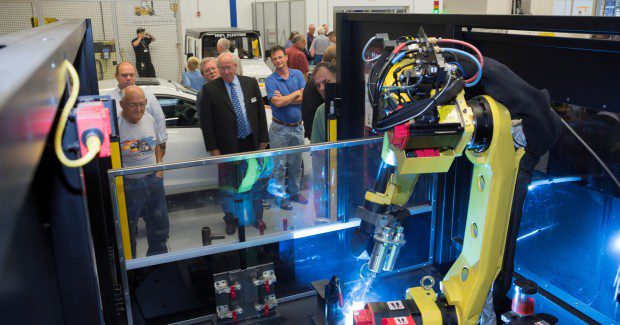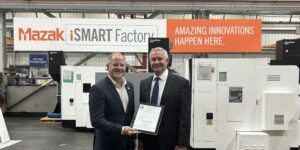Where Welding is Heading
The welding industry is headed down an evolutionary path that demands different, more knowledgeable welders, whether they work in a fab shop or out in the field. Each of these areas needs welding specialists who have different skill sets.
Posted: September 25, 2015
We once were able to train welders in a relatively short time period, when all that was needed was a good demonstration and plenty of booth time. We could pride ourselves on the fact that we could train a welder in weeks as compared to today’s training programs that take months. But as welding has matured into a more sophisticated industry and the demand for automation on the shop floor has grown, so too has the need for more specialized welders who understand beyond just how to hold a torch and weld. Today’s welding operators encounter advanced equipment and more stringent requirements for quality control and code compliance on the job each day.
The industry faces a hiring conundrum, however. Recent figures from the U.S. Bureau of Labor Statistics project that the number of welding jobs will increase by 6 percent by 2022, and the American Welding Society (AWS; Miami, FL) predicts an even larger increase of 10 percent. However, Manpower Groups annual Talent Shortage Survey, released in mid-May reveals that 32 percent of U.S. employers face issues in filling open positions, with skilled vacancies remaining in the No. 1 position as “hardest to fill.” This number has decreased from 40 percent last year to 8 percent this year; but, it still remains a challenge.
To fill the growing number of available jobs in a market where the workforce has shrunk considerably over the past 30 years, you need to break down the disconnect that exists between employers, education and prospective employees and help all parties understand there is a distinct difference between a trained welder and an educated one.
Today’s welders must work with higher levels of specialization, not only in equipment but also in applications. Exotic materials, including aluminum and advanced high-strength steels, are becoming more widely used. Yet, many welders in the shop don’t know how to address all of this specialization. They might be trained and be excellent welders, but they aren’t specialized and knowledgeable.
The agriculture industry faced a similar challenge many years ago. People used to learn to farm from relatives, with skills passed down from generation to generation through hands-on instruction. These farmers were trained. By the 1960s, the industry had shifted to one that required not just trained workers, but educated ones who could address the science behind agriculture. In the 1990s, agricultural education further evolved to address new specializations and has since grown dramatically. It has become a specialized field of study and employment, with areas of interest ranging from animal husbandry to agronomy to forestry to plant genetics to advanced GPS (Global Positioning Systems) controls, to name a few.
This is where the welding industry is headed – an evolutionary path that demands different, more knowledgeable welders, whether they work in a fab shop, a manufacturing plant or out in the field. Each of these areas needs welding specialists who have different skill sets.
When we read that we’ll need 378,000 welders by 2022, what does that really mean? Are these welders who only pull triggers and burn rod? Or does this number also include engineers, technologists, robotic welding operators, mechanized orbital system operators, laser welding cell technicians, quality control engineers, and other more specialized roles required in welding operations today and into the future?
Ask yourself this: Who is going to fill the open jobs for inspectors down the road? Who is going to be capable of running the automated cells on your shop floor, which demands a different way to work than manual welding? Having the right employees on your shop floor or in the field depends more on education, not just skills training.
Not every future new hire will need to have a four-year welding engineering degree. We always will need welders who can perform manual welding tasks. We’ll also need operators who have trained at a two-year institution and earned an associate’s degree. Regardless, one thing is certain: the level and scope of education required for emerging technology must be advanced, not only for new welders coming out of school but also for those existing employees on your shop floor who show potential.
The concept of lifelong learning and development, from initial training to retirement, has begun to spur industry-education partnerships, where leading companies team up with career-technical schools, community colleges and universities to share know-how and technology in an effort to educate the industrial workforce. RAMTEC in central Ohio is one such example.
RAMTEC (Robotics Advanced Manufacturing Technical Education Collaborative) grew out of a partnership between Tri-Rivers Career Center, Marion Technical College and The Ohio State University at Marion. These schools have partnered with Yaskawa®, Fanuc®, Honda®, RobotWorx® and Lincoln Electric to operate a training center in Marion, OH, that focuses exclusively on robotics and advanced manufacturing. Welding plays a role in the curriculum, and training is hands-on and intensive.
The center’s programming reaches across multiple student populations, from high school and college students to existing workers seeking to advance their skills or ones participating in the center’s industrial training program that provides them with exposure to robotics. It works, and the state of Ohio has noticed. RAMTEC has received $15 million from the state’s Straight A grant program to expand to eight additional centers across the Ohio.
In the end, welding is welding – a job where someone or something welds two pieces of metal together. The basic premise of this hasn’t changed, but the way the industry does it, thanks to new tools and technologies, is changing. And, so is how we educate both our future and existing workforce. We don’t need entry level welders who only know how to weld metal. We need new people coming into the industry who have skills today that would have been considered mid-level skills even five or ten years ago.
To make this happen, we must change how we educate our workforce – future and existing – to meet the industry’s long-term goals so we can maintain a competitive edge in the global marketplace. Our industry has matured into a diverse group of disciplines and we need to properly educate workers with a different approach to education than we have in the past. We need people who not only know how to weld but who also can think strategically and technically.
















